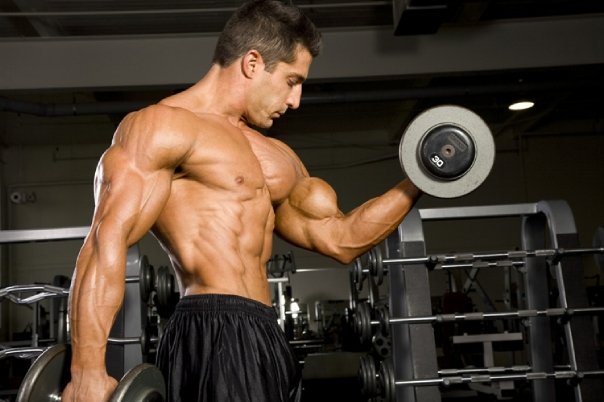Biceps are like burgers. Everyone loves them. Ask a child to make a muscle and he or she will strike a biceps shot. Bi’s are not only synonymous with posing, but also with exercise and after your first year in the gym, you’ve probably read, heard or absorbed so much about curling that you’re tempted to skip ahead. Don’t. This article is for you, because it’s likely you’re making at least some of the following errors. This month, we’ll examine the most frequent biceps training blunders and lay out a plan for correcting each so that your curling course earns you an A in gun gains.

#1 Cheating too early
Biceps curls are probably the easiest exercises to cheat. Whenever your arms are not resting on a bench (as during a preacher or machine curl), all it takes is a little swing to shift some tension from your arms to your front delts and make a hard rep easier. Cheating is a valuable tool for pushing sets beyond strict, full-rep failure, but if you do so before then, it’s unlikely you will ever thoroughly stress your bi’s. In an effort to hump up heavier weights than they could otherwise use, many bodybuilders start cheating on curls from rep number one and increase their swinging as the set wears on.
Solutions
- Do strict reps until you reach failure. If necessary, stand with your back against a wall during barbell or EZ-bar curls and/or press your elbows against your sides.
- To remove your legs and hips from the movement, do dumbbell curls while seated.
- To push sets beyond strict, full-rep failure, do two or three extra reps with a slight arm swing.
# 2 Doing too much
The popularity of biceps doesn’t make them any larger in relation to their peers. Compared with your lats and quadriceps, your bi’s are puny, so if you’re pumping out as many sets in your biceps workout as your back workout, you’re likely piling on the “little guys.” More than any other muscles, biceps are frequent victims of overtraining, which halts or even reverses their gains.
Solutions
- Beginners should do only six sets for biceps. After four months of training, you can gradually add sets.
- Advanced bodybuilders should typically do nine to 12 sets for biceps.
- At maximum, push only the final set of an exercise beyond failure via techniques like cheating, forced reps, negatives and drop sets.
#3 Missing the target
More pabulum has been published about arm training than any other bodypart. For example, not long ago it was preached as gospel that to accentuate your lower biceps, “thou shalt do preacher curls” and to accentuate your biceps peaks, “thou shalt do concentration curls.” Neither “tenet” is true, so it’s no wonder that so many bodybuilders fire off curls but miss their intended targets. In fact, you can’t put any greater emphasis on your lower biceps than the rest of the muscle, and merely focusing on peak contractions won’t raise your peaks.
Solutions
- Focus on the two heads of your biceps, which rest side by side.
- Perform biceps curls with a grip that keeps the pinkies even with or higher than the other fingers to better recruit the biceps brachii short head (inner side). You also use the short head more when you take a wide grip on the bar.
- Perform curls with the thumbs higher than the pinkies–as when taking an angled grip on an EZ-bar or when using a parallel grip for hammer curls–to better target the biceps brachii long head (outer side). You also engage the long head more when you take a narrow grip on a bar. Growing the long head can boost the slope of your biceps, thus accentuating the peak in poses such as the front double biceps.
- Don’t expect to go from flat to barbed if it’s not preordained in your DNA, because the shape of your biceps is largely genetic.
You should focus instead on maximizing bi size.

# 4 Not incorporating sufficient variety
Although the biceps are simple, two-headed muscles targeted almost exclusively via curls, you still need to perform various types of curls to properly tax the manifold fibers. Too many bodybuilders get in a lazy pattern of doing, for example, all standing, bilateral, free-weight curls.
Solutions
- Do one EZ-bar or barbell curl exercise, one dumbbell curl exercise, and one machine or cable curl exercise each workout.
- Do one of the exercises standing, one seated and one with the working arm(s) restricted against your body or a bench.
- Do at least one unilateral exercise each biceps workout.
- On occasion, do a unique exercise–such as drag curls, underhand chin-ups and rope hammer curls–to hit your bi’s from different angles.
# 5 Skimping on contractions
The contraction is the crucial component of a curl, so it’s unfortunate that so many bodybuilders never truly flex their bi’s against resistance. Generally, this is because they use too much weight and perform their reps quickly and with excessive momentum.
Solutions
- Use a weight you can manage for eight to 12 strict, full reps.
- Curl slowly. Take approximately two seconds to raise the weight, hold the contraction for one second, then take approximately two seconds to lower the weight.
- During dumbbell curls, supinate your wrists so that your palms are facing your sides at the bottom of the movement and facing up at the contraction.
- Make every curl a “concentration curl” by flexing your biceps at each contraction.
Lessons Learned
- Perform strict, full reps. Cheat only to extend a set.
- Use low to moderate volume.
- Target your outer head to accentuate your bi peaks.
- Do dissimilar types of curls in the same workout.
- Control the weight and emphasize contractions.
No comments:
Post a Comment